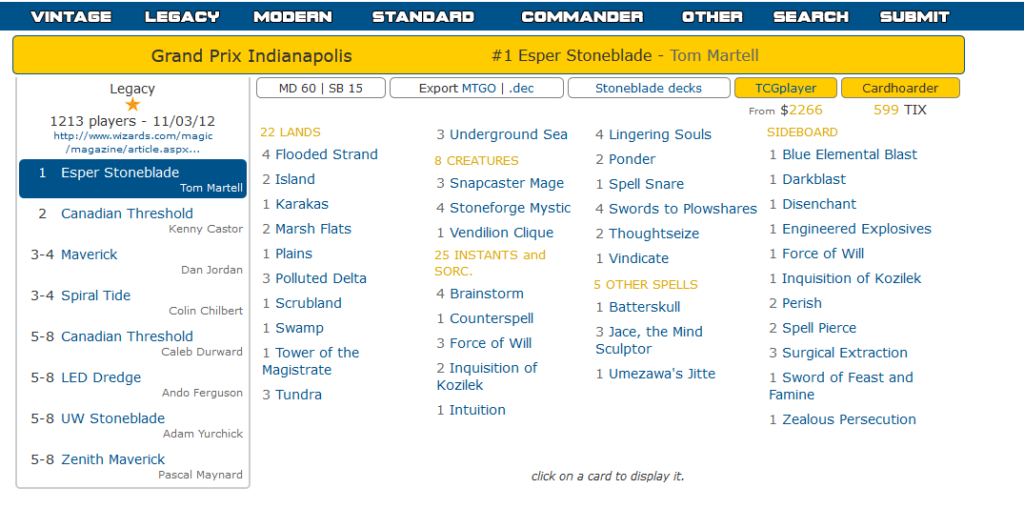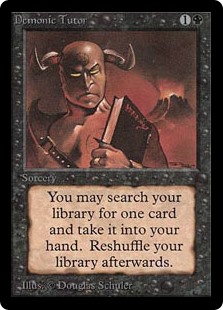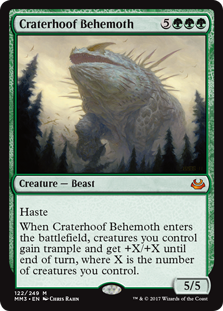When it comes to deckbuilding, figuring out how many copies of a card to play in particular can feel more like an artform than a science. You either trust the public perception or try to get a feel for how many copies feels right through playtesting. This article will break down the process of tweaking the numbers so that we can approach the problem more rationally.
Some cards are obvious four-ofs. They are empirically proven to be very powerful or central to your strategy in some way, and you’d play a fifth copy if the rules allowed it. The decision to play four Brainstorm in your blue Legacy deck really isn’t much of a decision. Sometimes however, things are not so clear, and we need to consider playing fewer copies. In my sideboarding article from two weeks ago I briefly mention the concept of diminishing returns.
Diminishing returns means that the value per unit decreases the more units there are in such a way that the second unit adds less value than the first one, the third unit adds less than the second, and so on. Having one cookie is a lot better than having zero cookies, whereas the difference between a thousand cookies and a thousand-and-one cookies is negligible. The key is finding the point where the value of an additional unit has diminished to the point that you’d be better off spending your resources elsewhere. To accomplish this we need to look at why there are diminishing returns in the first place.
Example #1: Blood Moon
Cards with static abilities that don’t stack, like Blood Moon or Stony Silence, have diminishing returns because additional copies don’t further affect the game. A second moon effect can work as insurance against a potential removal spell from your opponent, but the effect itself is the same no matter how many are in play.
Example #2: Searing Blaze
Burn is one of the most linear strategies in the history of the game, and it works because of the incremental power of your cards. When playing Burn you need to think carefully before spending one of your cards doing anything other than getting your opponent’s life total closer to zero, and you’re often forced to choose between bolting their face or killing their creatures. Searing Blaze circumvents this problem by dealing damage to both your opponent and their creature. The problem is that if they don’t have a creature it becomes a dead card. Luckily for the Burn players, even the decks that don’t classify as creature decks still tend to play some number of creatures (hello Snapcaster Mage) so you can usually find a target for at least one Searing Blaze. The more reactive cards you play the higher the likelihood that you will run out of targets for them—or that you will have to spend them on weaker targets.
Example #3: Gurmag Angler
I’ve discussed this one before, so I won’t linger on the subject. The point is that the first Gurmag Angler eats up the cards in your graveyard, making the second one more difficult to cast.
Example #4: Basic lands
Let’s take a look at Tom Martell’s Esper Stoneblade list from GP Indianapolis.
Notice the basic lands in this list:
2 Island
1 Plains
1 Swamp
Exactly enough basic lands to be able to cast any spell in the deck through a Blood Moon or Wasteland. No more, no less. Just four basic lands is enough to play around Wasteland, because of your ability to find them with your fetchlands. Island is not as powerful as Tundra, but having it in your deck makes your fetchlands better by giving you the option to search for it.
This brings us to the next segment of this article; library manipulation. Knowing you want to draw exactly one copy of a certain card doesn’t necessarily mean you shouldn’t play more than that. There are a bunch of considerations we need to take into account, such as at what point in the game you need the card, what happens if you don’t find it, and how bad it would be to draw more than the ideal number. Various forms of card selection, such as the aforementioned fetchlands, can help provide consistency by letting you see more cards.
Silver bullets are cards that are very good in specific scenarios, but below average the rest of the time. For this reason you tend to not want to draw them outside of those specific matchups and scenarios in which they are at their best. Instead you stick a single copy, allowing you to search it up with your Green Sun’s Zenith or Recruiter of the Guard. Cantrips work similarly to tutors, with the difference being that they only search a small subset of your library. Thus they cannot find your one-ofs as reliably.
I want to talk for a bit about resiliency. If you’re playing a card, you’re probably doing so for a reason. If your opponent gets rid of it somehow it’s nice to have access to a second copy. Let’s look at some examples.
A RUG Delver manabase typically looks something like this:
4 Wasteland
8 fetchlands
3 Tropical Island
3 Volcanic Island
RUG Delver rarely needs to have six lands in play, but playing three of each dual makes you a lot more resilient to land destruction. Going below three copies would make you highly susceptible to Wasteland, as a mere two wastelands would be enough to permanently cut you off of an entire color. Hardly a sacrifice you’re willing to make.
There is also the awkward scenario of having to hold on to a singleton effect you happen to draw early in the game or lose an important tool later on. A Miracles player might want to use Entreat the Angels early in the game to kill an opposing planeswalker, but without a second copy in your deck the cost to doing so is much higher—especially in matchups where Entreat the Angels is vital to your strategy.
Elves plays two copies of Craterhoof Behemoth largely because not having one left in your library significantly weakens your Natural Order—a card that otherwise often straight up wins you the game if it resolves.
Wrapping up
Tweaking the numbers is a complicated process. There are a lot of variables to factor in, and you need a good understanding of your deck as well as its various matchups to properly go about finding the right configuration. The following is a good rule of thumb, but keep in mind that that’s all it is.
Four-ofs are typically cards that are both powerful and efficient, or ones that are a key part of your strategy. Brainstorm and Deathrite Shaman are two of the best cards in Legacy, and they are automatic four-ofs in virtually every deck that plays them. Decks with Aether Vial or Delver of Secrets are built to maximize the power of those cards, so you will rarely come across a list with less than the full playset.
Three-ofs tend to be cards that are very good, but can get a bit clunky in multiples. Jace, the Mind Sculptor is an excellent card, but you don’t need more than one, and you don’t need it that early anyways. Sometimes you can also shave a copy of what would normally be a four-of in favor of more library manipulation, thereby giving you more control over your draws and reducing the risk of you drawing the wrong half of your deck, especially in pre sideboard games.
Two-ofs are a bit trickier. You tend to be fine with drawing them naturally, although the main reason they are there is to diversify your cards, especially if you have access to some amount of card selection. Having the second one around also means you can play the first one without having to worry about not being able to find another one later on.
One-ofs are typically tutor targets or cards that grant you inevitability in some way. Tuktuk Scrapper is quite underwhelming in most situations, but being able to search for it with Goblin Matron when you need to destroy a Sword of Fire and Ice is very important.
Ask yourself why you’re playing with a certain number of the same card. Becoming aware of the decisions you’re making and then thinking critically about them are the first steps toward improving those decisions.
Sandro is a Magic player from Stockholm, Sweden. He’s been playing Goblins in Legacy for years. Follow him on Twitter @SandroRajalin




